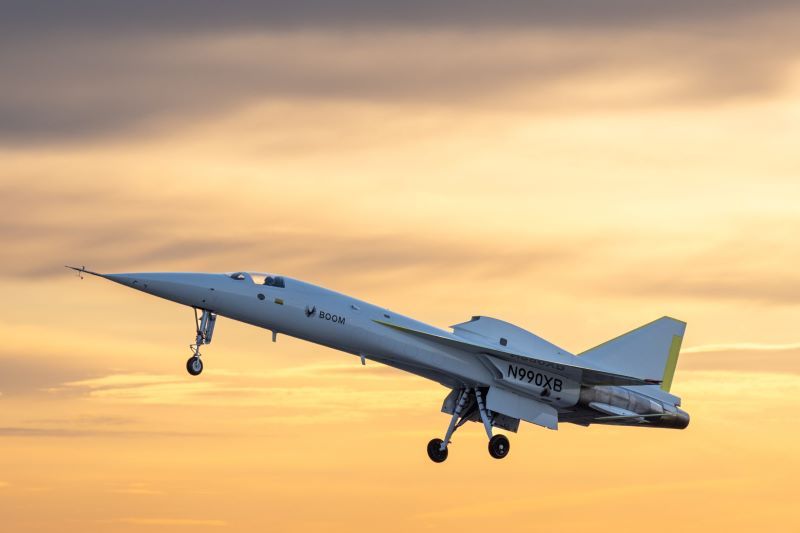Boom’s XB-1 supersonic jet made its maiden flight at the Mojave Air & Space Port in Mojave last week.
XB-1 is a prototype aircraft that is validating technologies and design features that will be used on Boom’s planned Overture airliner. These include an augmented reality vision system, aerodynamics tweaked for supersonic flight, composite materials, and engine intakes that slow down the speed of incoming air.
US-based Boom is developing the Mach 1.7 Overture airliner to carry up to 80 passengers and has a range of 4,900 miles (7,885km). The aircraft will be powered by three non-afterburning, medium-bypass turbofan engines, two under the wings and one in the tail.
Boom plans to roll out the first completed Overture aircraft in 2026, with certification and entry into service planned by 2029.
XB-1 is 62.6ft (19m) long with a wingspan of 21ft (6.4m) and is powered by three GE J85-15 engines with a combined max thrust of 12,300 pounds of force (lbf).
XB-1 met all its test objectives during the first flight, including achieving an altitude of 7,120ft and speeds of up to 273 mph (440km/h). Flight test engineers performed an initial assessment of the aircraft’s handling qualities, including airspeed checks with the T-38 chase aircraft, and assessing the aircraft’s stability in the landing attitude at a high angle of attack.
The flight test team will next expand XB-1’s flight envelope to confirm its performance and handling qualities at speeds faster than Mach 1.

Supersonic technology under test
XB-1 is validating key technologies and Boom’s own innovations, including:
Augmented reality vision system: Two nose-mounted cameras, digitally augmented with attitude and flight path indications, feed a high resolution pilot display enabling excellent runway visibility. This system enables improved aerodynamic efficiency without the weight and complexity of a movable nose.
Digitally-optimized aerodynamics: Engineers used computational fluid dynamics simulations to explore thousands of designs for XB-1. The result is an optimized design that combines safe and stable operation at takeoff and landing with efficiency at supersonic speeds.
Carbon fiber composites: XB-1 is almost entirely made from carbon fiber composite materials, enabling it to realize a sophisticated aerodynamic design in a strong, lightweight structure.
Supersonic intakes: XB-1’s engine intakes slow supersonic air to subsonic speeds, efficiently converting kinetic energy into pressure energy, allowing conventional jet engines to power XB-1 from takeoff through supersonic flight.
Test pilots hail milestone flight
XB-1 was flown by chief test pilot Bill “Doc” Shoemaker, XB-1 took off from the Mojave Air & Space Port March 22.
Shoemaker said, “It has been a privilege to share this journey with so many dedicated and talented professionals. The experience we have gained in reaching this milestone will be invaluable to Boom’s revival of supersonic travel.”
Test pilot Tristan “Geppetto” Brandenburg flew the T-38 chase aircraft which monitored XB-1 in the air. He said, “The team has been working hard to get to this point, and seeing today’s flight through mission completion is a huge accomplishment for all of us.”
Boom has 130 an order book including 130 orders and pre-orders from American Airlines, United Airlines, and Japan Airlines for Overture and has formed partnerships with several Tier 1 suppliers for its production.
Blake Scholl, founder and CEO of Boom Supersonic said, “XB-1 took flight in the same hallowed airspace where the Bell X-1 first broke the sound barrier in 1947. I’ve been looking forward to this flight since founding Boom in 2014, and it marks the most significant milestone yet on our path to bring supersonic travel to passengers worldwide.”




